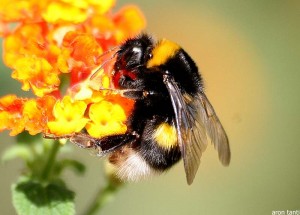Although most gardeners and farmers may list weeding or irrigation as important steps in growing vegetables, maybe the most important step of all isn’t even done by humans. Hard-working but often overlooked animals, including not just insects, but birds and mammals are responsible for pollination, a process in which pollen is transferred from the male part (anthers) of one flower to the female part (stigma) of the same or another flower resulting in fertilization and the eventual production of fruit.

According to a 2007 article in the Proceedings of the Royal Society, an estimated 35 percent of global agricultural output depends on animal pollination, and 87 of the 115 most widely-used food crops, including many of the most nutritious fruits and vegetables, require animal pollination to be productive. The remaining output comes largely from grain crops like maize, rice, and wheat that are wind-pollinated.
Some scientists have even tried to estimate the economic value of pollination, placing it at about 212 billion USD or 9.5 percent of the value of global agricultural output. And because no data are collected about pollination services, none of these figures accounts for subsistence farming which often utilizes pollination-dependent crops.
In other words, global food/nutritional security and agricultural biodiversity depend largely on successful pollination by animals.
It’s alarming, then, that in the past decade scientists and citizens alike have noted significant pollination deficits, indicated by the fact that plants do not set seed or fruit after flowering, in wild plant communities and agricultural croplands the world over. Though it’s difficult to confirm since small insects can be hard to census, these deficits are likely due to declines in global pollinator populations.
Many Americans may be familiar with the mysterious Colony Collapse Disorder that has devastated feral and managed honeybee colonies across the country— nearly 25 percent of American beekeepers have reported losses attributable to CCD in the past few years. And although a recently published study has attributed CCD to a combination of a fungal and viral infection that together are deadly, honeybees still face a variety of other problems, including overuse for commercial pollination services, narrow genetic resources, and mites.
The lesser known casualties are those species of bumblebees, solitary bees, flies, and wasps that are quickly disappearing as farmers move to monoculture, farms consolidate, and land is developed, eliminating the wooded hedgerows and floral diversity they once depended on. In many ways, the landscape modern agriculture is creating is inhospitable to the insects vegetable and fruit crops need to be productive.
Alarmed by early figures about pollination deficits, a group of scientists at the 2000 UN Convention on Biodiversity called for the creation of an International Pollinator Initiative (IPI), aimed at further assessing the crisis, researching best management practices, educating farmers and citizens, and prioritizing pollinators in agricultural policy worldwide. A five-year companion project with UN Environment Program (UNEP) and Global Environmental Facility (GEF) called the Global Pollination Project began in 2008 in Brazil, Ghana, India, Kenya, Nepal, Pakistan, and South Africa to build capacity and knowledge among farmers and stewards.
By educating people on how to identify different pollinators essential to their local ecosystems and agriculture and promoting ecologically sound agriculture, this project hopes to protect pollinators by involving citizens in their conservation. What’s more, this initiative is also generating projects and ideas, like raising native African stingless honeybees, that provide the dual benefit of protecting pollinators and providing economic benefit to rural citizens in the initiative’s target countries. Global pollinators may be in crisis, but the Global Pollination Project is finding ways to turn that crisis into opportunity.

Danielle Nierenberg, an expert on livestock and sustainability, currently serves as Project Director of State of World 2011 for the Worldwatch Institute, a Washington, DC-based environmental think tank. Her knowledge of factory farming and its global spread and sustainable agriculture has been cited widely in the New York Times Magazine, the International Herald Tribune, the Washington Post, and
other publications.
Danielle worked for two years as a Peace Corps volunteer in the Dominican Republic. She is currently traveling across Africa looking at innovations that are working to alleviate hunger and poverty and blogging everyday at Worldwatch Institute’s Nourishing the Planet. She has a regular column with the Mail & Guardian, the Kansas City Star, and the Huffington Post and her writing was been featured in newspapers across Africa including the Cape Town Argus, the Zambia Daily Mail, Coast Week (Kenya), and other African publications. She holds an M.S. in agriculture, food, and environment from Tufts University and a B.A. in environmental policy from Monmouth College.










